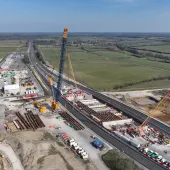Video: HS2 start year-long Wendover Dean deck slide
Engineers have begun the delicate, year-long job of sliding an almost half a kilometre long bridge deck into position high above the Misbourne Valley in Buckinghamshire, as HS2’s innovative Wendover Dean Viaduct enters a critical new stage of construction.
The 450m-long viaduct will be the first major railway bridge in the UK to be built with a ‘double composite’ approach, which uses significantly less carbon-intensive concrete and steel than a more traditional design and has allowed HS2 to halve the amount of embedded carbon in the structure.
It is one of 50 major viaducts on the HS2 project, which is designed to improve connections between London, Birmingham, and the North while freeing up space on the most congested southern end of the existing West Coast Main Line.
Instead of using solid pre-stressed concrete beams to form the spans between the viaduct piers, the ‘double composite’ structure uses two steel beams sandwiched between two layers of reinforced concrete to create a lightweight and super strong hollow span.
Due to the length of the viaduct, the deck is being assembled in three stages, ranging from 90m to 180m sections, with each one pushed out from the north abutment before the next section is attached behind it. This painstaking process means that the weight of the deck will increase with each push, up from an initial 590 tonnes this week to 3700 tonnes by the end of the year.
Tomas Garcia, HS2’s head of civil structures said: “Double composite structures maximise the combined strength of steel in tension and concrete in compression. This approach has been tried and tested around the world and it’s great to see it applied on this scale for the first time in the UK at Wendover Dean.
The viaduct is being built by HS2’s main works contractor, EKFB (Eiffage, Kier, Ferrovial Construction and BAM Nuttall) with the manufacture and installation of the beams being led by specialists at Eiffage Metal.
A winch is used to push the deck forward at a speed of around 9m/hr, sliding across Teflon pads to reduce friction. It is the longest deck slide on the HS2 project to date.
At this point in the Chilterns the railway will be on a slight gradient, so to help maintain control, the deck, which will eventually weigh the same as 264 double-decker buses, is being pushed slightly uphill, with the finish point approximately 1.8m higher than start point.
EKFB worked with their design partner, ASC (Arcadis, Setec and COWI) and architects Moxon on the ‘double composite’ approach, which was inspired by structures on the French high-speed TGV network.
The approach is set to cut the carbon footprint of the structure by 56% – saving almost 13,000 tonnes of embodied carbon – and helping HS2 achieve its goal of halving the amount of embedded carbon in construction.
The beams are made of ‘weathering steel’ which naturally fades to a dark brown colour over time and will help match the natural tone of the surrounding countryside. A similar approach – using weathering steel and a double composite structure - is also being taken at the nearby Small Dean Viaduct which is currently at a much earlier stage of construction.
Weathering steel gets its characteristic colour from a surface layer of corrosion which protects the steel and removes the need for regular painting.
The Wendover Dean Viaduct will be supported by nine evenly spaced piers, some of which will be up to 14m high. These consist of a series of hollow pre-cast concrete shells, manufactured in Northern Ireland, which are placed on top of each other and filled with concrete and steel reinforcing.
This approach was chosen to enable a crisp, clean external finish to the concrete, cut the amount of work on site and reduce disruption for residents.
The last few months have also seen significant progress at HS2’s other major viaducts, with the first concrete poured for the approach viaducts for Birmingham Curzon Street station, the first beams installed at Thame Valley near Aylesbury and the Delta Junction in North Warwickshire.
In total, HS2 is building more than 500 bridging structures – ranging from small road bridges to massive viaducts like the record-breaking Colne Valley Viaduct, which at 3.38km will become the longest in the UK.
James Collings, EKFB’s senior engineer, said: “The project team has reached a fundamental milestone in the build of this industry-leading viaduct. We’re progressing well with the first of three steel launches being conducted this year and already looking forward to seeing this viaduct come to life. Along with our supply chain partners, Eiffage Metal, we’re proud to be delivering this viaduct safely and to programme.”

















